El ejercicio físico en el aula para la mejora del comportamiento de niños autistas
DOI:
https://doi.org/10.24310/riccafd.2019.v8i1.5792Palabras clave:
actividad física, condición física, comportamiento, colegio, revisiónResumen
El objetivo de este trabajo fue analizar todos los estudios que midieron el efecto a medio plazo de intervenciones educativas basadas en ejercicio físico sobre el comportamiento y conducta de niños (6 - 12 años de edad) diagnosticados con Trastorno del Espectro Autista (TEA). Para ello se hizo una revisión bibliográfica en tres bases de datos (búsqueda inicial n = 184: PubMed n = 24, SportDiscus n = 98, Web of Science n = 62). Se limitaron las fechas de búsqueda desde enero de 2000 hasta enero de 2018. Un total de cinco estudios longitudinales con intervención cumplieron los criterios de inclusión. Todos los estudios son recientes, el más antiguo fue publicado en 2011. Los cinco trabajos emplearon programas de ejercicio físico en el ámbito escolar __ 3-5 días / semana __ con duración de 2-20 semanas. Las sesiones realizadas en días de clase tuvieron una duración de 15-30 minutos, las realizadas en vacaciones escolares cuatro horas. Tres estudios obtuvieron mejoras en comportamiento tras la intervención educativa, sin embargo, dos estudios no obtuvieron cambios significativos en las variables medidas. Se concluye que la integración del ejercicio físico en el ámbito escolar mejora el comportamiento y conducta (intereses restrictivos o repetitivos y comportamientos estereotipados) en niños diagnosticados TEA. Como perspectivas futuras se sugiere profundizar en la influencia de los factores de confusión y en el efecto diferencial del efecto a corto, medio y largo plazo de estas intervenciones educativas basadas en el ejercicio físico.
Descargas
Métricas
Citas
Altenburg, T. M., Chinapaw, M. J. M., y Singh, A. S. (2015). Effects of one versus two bouts of moderate intensity physical activity on selective attention during a school morning in Dutch primary schoolchildren: A randomized controlled trial. Journal of Science and Medicine in Sport, 19(10), 820-824. doi: 10.1016/j.jsams.2015.12.003
Anderson-Hanley, C., Tureck, K., y Schneiderman, R. L. (2011). Autism and exergaming: effects on repetitive behaviors and cognition. Psychology research and behavior management, 4, 129. doi: 10.2147/PRBM. S24016
American Psychiatric Association (2013). Diagnostic and Statistical Manual of Mental Disorders (DSM-5®). American Psychiatric Pub.
Berse, T., Rolfes, K., Barenberg, J., Dutke, S., Kuhlenbaumer, G., Volker, K., …, Knecht, S. (2015). Acute physical exercise improves shifting in adolescents at school: evidence for a dopaminergic contribution. Frontiers in Behavioral Neuroscience, 9, 9. doi: 10.3389/fnbeh.2015. 00196
Brand, S., Jossen, S., Holsboer-Trachsler, E., Pühse, U., y Gerber, M. (2015). Impact of aerobic exercise on sleep and motor skills in children with autism spectrum disorders - a pilot study. Neuropsychiatric Disease and Treatment, 11, 1911–1920. doi: 10.2147/ndt.s85650
Cadenas-Sánchez, C., Mora-González, J., Migueles, J. H., Martín-Matillas, M., Gómez-Vida, J., Escolano-Margarit, M. V., … de Teresa, C. (2016). An exercise-based randomized controlled trial on brain, cognition, physical health and mental health in overweight/obese children (ActiveBrains project): Rationale, design and methods. Contemporary Clinical Trials, 47, 315–324. doi: 10.1016/j.cct.2016.02.007
Cohen, S., Conduit, R., Lockley, S. W., Rajaratnam, S. M. W., y Cornish, K. M. (2014). The relationship between sleep and behavior in autism spectrum disorder (ASD): a review. Journal of neurodevelopmental disorders, 6(1), 44. doi: 10.1186/1866-1955-6-44
Craig, F., Margari, F., Legrottaglie, A. R., Palumbi, R., de Giambattista, C., y Margari, L. (2016). A review of executive function deficits in autism spectrum disorder and attention-deficit/hyperactivity disorder. Neuropsychiatric Disease and Treatment, 12, 1191–1202. doi: 10.2147/ NDT.S104620
Cacho, C. D., & Vera, E. C. (2017). Relación entre la danza libre-creativa y autoestima en la etapa de educación primaria. Cuadernos de Psicología del Deporte, 17(1), 73-79.
Fedewa, A. L., y Erwin, H. E. (2011). Stability balls and students with attention and hyperactivity concerns: Implications for on-task and in-seat behavior. American Journal of Occupational Therapy, 65(4), 393–399. doi: 10.5014/ajot.2011.000554
Flohr, J. A., Saunders, M. J., Evans, S. W., y Raggi, V. (2004). Effects of physical activity on academic performance and behavior in children with ADHD. Medicine and Science in Sports and Exercise, 36(5), S145–S146.
González Hernández, J., y Baños Audije, L. M. (2012). Estudio sobre el cambio de actitudes hacia la discapacidad en clases de actividad física. Cuadernos de Psicología del Deporte, 12(2), 101-108.
Heyvaert, M., Saenen, L., Campbell, J. M., Maes, B., y Onghena, P. (2014). Efficacy of behavioral interventions for reducing problem,behavior in persons with autism: An updated quantitative synthesis of single-subject research. Research in Developmental Disabilities, 35(10), 2463–2476. doi:10.1016/j.ridd.2014.06.017
Hillier, A., Murphy, D., y Ferrara, C. (2011). A Pilot Study: Short-term Reduction in Salivary Cortisol Following Low Level Physical Exercise and Relaxation among Adolescents and Young Adults on the Autism Spectrum. Stress and Health, 27(5), 395–402. doi:10.1002/smi.1391
Ketcheson, L., Hauck, J., y Ulrich, D. (2017). The effects of an early motor skill intervention on motor skills, levels of physical activity, and socialization in young children with autism spectrum disorder: A pilot study. Autism, 21(4), 481-492. doi: 10.1177/1362361316650611
Khan, N. A., y Hillman, C. H. (2014). The relation of childhood physical activity and aerobic fitness to brain function and cognition: a review. Pediatric exercise science, 26(2), 138–146. doi: 10.1123/pes.2013-0125
Lai, M. C., Lombardo, M. V., y Baron-Cohen, S. (2014). Autism. Lancet, 383(9920), 896–910. doi: 10.1016/s0140-6736(13)61539-1
Leckie, R. L., Oberlin, L. E., Voss, M. W., Prakash, R. S., Szabo-Reed, A., Chaddock-Heyman, L., … Erickson, K. I. (2014). BDNF mediates improvements in executive function following a 1-year exercise intervention. Frontiers in Human Neuroscience, 8, 12. doi:10.3389/ fnhum.2014.00985
Liu, T., y Hamilton, M. (2013). The effects of physical activity on the stereotypic behaviors of children with autism spectrum disorder. Journal of Sport & Exercise Psychology, 35, S68–S68. doi: 10.17795/intjsh-28674
Nicholson, H., Kehle, T. J., Bray, M. A., y Heest, J. V. (2011). The effects of antecedent physical activity on the academic engagement of children with autism spectrum disorder. Psychology in the Schools, 48(2), 198–213. doi: 10.1002/pits.20537
Oriel, K. N., George, C. L., Peckus, R., y Semon, A. (2011). The effects of aerobic exercise on academic engagement in young children with autism spectrum disorder. Pediatric Physical Therapy, 23(2), 187–193. doi: 10.1097/PEP.0b013e318218f149
Ortega, F. B., Artero, E. G., Ruiz, J. R., España-Romero, V., Jiménez-Pavón, D., Vicente-Rodríguez, G., … Ottevaere, C. (2011). Physical fitness levels among European adolescents: the HELENA study. British journal of sports medicine, 45(1), 20–29. doi: 10.1136/bjsm.2009.062679
Pan, C. Y., Chu, C. H., Tsai, C. L., Sung, M. C., Huang, C. Y., y Ma, W. Y. (2017). The impacts of physical activity intervention on physical and cognitive outcomes in children with autism spectrum disorder. Autism: The International Journal Of Research And Practice, 21(2), 190–202. doi: 10.1177/ 1362361316633562
Piepmeier, A T, Shih, C. H., Whedon, M., Williams, L. M., Davis, M. E., Henning, D. A., … Etnier, J. L. (2015). The effect of acute exercise on cognitive performance in children with and without ADHD. Journal of Sport and Health Science, 4(1), 97–104. doi: 10.1016/j.jshs.2014.11.004
Raichlen, D. A., y Polk, J. D. (2013). Linking brains and brawn: exercise and the evolution of human neurobiology. Proceedings of the Royal Society of London B: Biological Sciences, 280(1750), 9. doi: 10.1098/rspb. 2012.2250
Sánchez-Meca, J., y Botella, J. (2010). Revisiones sistemáticas y meta-análisis: Herramientas para la práctica profesional. Papeles del Psicólogo, 31(1), 7-17.
Sardinha, L. B., Marques, A., Martins, S., Palmeira, A., y Minderico, C. (2014). Fitness, fatness, and academic performance in seventh-grade elementary school students. BMC pediatrics, 14(1), 1. doi: 10.1186/1471-2431-14-176
Schmidt, M., Benzing, V., y Kamer, M. (2016). Classroom-based physical activity breaks and children’s attention: Cognitive engagement works! Frontiers in psychology, 7, 1-13. doi: 10.3389/fpsyg.2016.01474
Sowa, M., y Meulenbroek, R. (2012). Effects of physical exercise on Autism Spectrum Disorders: A meta-analysis. Research in Autism Spectrum Disorders, 6, 46–57. doi: 10.1016/j.rasd.2011.09.001
Suarez-Manzano, S., Ruiz-Ariza, A., De La Torre-Cruz, M., & Martínez-López, E. J. (2018). Acute and chronic effect of physical activity on cognition and behaviour in young people with ADHD: A systematic review of intervention studies. Research in developmental disabilities, 77, 12-23. doi: 10.1016/j.ridd.2018.03.015
Vander Net, J., y Sprong, M. (2011). Clinical bottom line. Commentary on “The effects of aerobic exercise on academic engagement in young children with autism spectrum disorder.” Pediatric Physical Therapy, 23(2), 187-193. doi: 10.1097/PEP.0b013e3182193630
Publicado
Cómo citar
Número
Sección
Licencia
Todos los contenidos publicados en Revista Iberoamericana de Ciencias de la Actividad Física y el Deporte están sujetos a la licencia Creative Commons Reconocimento-NoComercia-Compartirigual 4.0 cuyo texto completo puede consultar en <http://creativecommons.org/licenses/by-nc-sa/4.0>

Se pueden copiar, usar, difundir, transmitir y exponer públicamente, siempre que:
- Se cite la autoría y la fuente original de su publicación (revista, editorial y URL de la obra).
- No se usen para fines comerciales.
- Se mencione la existencia y especificaciones de esta licencia de uso.
Los derechos de autor son de dos clases: derechos morales y derechos patrimoniales. Los derechos morales son prerrogativas perpetuas, irrenunciables, intransferibles, inalienables, inembargables e imprescriptibles.
De acuerdo con la legislación de derechos de autor, Revista Iberoamericana de Ciencias de la Actividad Física y el Deporte reconoce y respeta el derecho moral de los autores/as, así como la titularidad del derecho patrimonial, el cual será cedido a la Universidad de Málaga para su difusión en acceso abierto.
Los derechos patrimoniales, se refieren a los beneficios que se obtienen por el uso o divulgación de las obras. Revista Iberoamericana de Ciencias de la Actividad Física y el Deporte se publica en open access y queda autorizada en exclusiva para realizar u autorizar por cualquier medio el uso, distribución, divulgación, reproducción, adaptación, traducción o transformación de la obra.
Es responsabilidad de los autores/as obtener los permisos necesarios de las imágenes que están sujetas a derechos de autor.






.png)








9.png)
